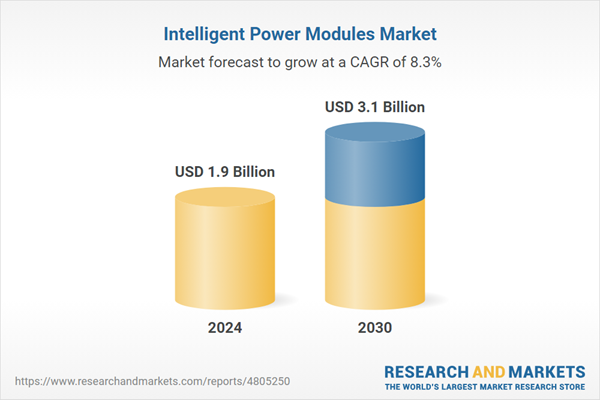The global market for Intelligent Power Modules was valued at US$1.9 Billion in 2024 and is projected to reach US$3.1 Billion by 2030, growing at a CAGR of 8.3% from 2024 to 2030. This comprehensive report provides an in-depth analysis of market trends, drivers, and forecasts, helping you make informed business decisions. The report includes the most recent global tariff developments and how they impact the Intelligent Power Modules market.
Segments: Voltage Rating (Below 600 V, 600 - 1,200 V, Above 1,200 V); Power Device (IGBT, MOSFET); Vertical (Industrial, Consumer Electronics, ICT, Automotive, Aerospace, Other Verticals).
Geographic Regions/Countries: World; United States; Canada; Japan; China; Europe (France; Germany; Italy; United Kingdom; Spain; Russia; and Rest of Europe); Asia-Pacific (Australia; India; South Korea; and Rest of Asia-Pacific); Latin America (Argentina; Brazil; Mexico; and Rest of Latin America); Middle East (Iran; Israel; Saudi Arabia; United Arab Emirates; and Rest of Middle East); and Africa.
The analysts continuously track trade developments worldwide, drawing insights from leading global economists and over 200 industry and policy institutions, including think tanks, trade organizations, and national economic advisory bodies. This intelligence is integrated into forecasting models to provide timely, data-driven analysis of emerging risks and opportunities.
Global Intelligent Power Modules Market - Key Trends & Drivers Summarized
What Are Intelligent Power Modules and Why Are They Integral to Modern Power Electronics?
Intelligent Power Modules (IPMs) are advanced semiconductor devices that integrate power switches, gate drivers, and protection features into a single, compact module. These modules are integral to modern power electronics because they simplify the design of power conversion systems, improve efficiency, and enhance reliability. IPMs are widely used in applications such as motor drives, renewable energy systems, and industrial automation, where efficient and reliable power management is crucial. By combining multiple functions into one module, IPMs reduce the component count, minimize design complexity, and offer built-in protection against overcurrent, overheating, and short circuits. As industries increasingly demand higher efficiency and more compact power solutions, the role of IPMs in enabling these advancements is becoming more prominent.How Are Technological Advancements Shaping the Intelligent Power Modules Market?
Technological advancements are significantly influencing the Intelligent Power Modules (IPMs) market, particularly through innovations in semiconductor materials, thermal management, and integration capabilities. The development of wide bandgap materials, such as silicon carbide (SiC) and gallium nitride (GaN), is enhancing the performance of IPMs by allowing for higher switching frequencies, improved efficiency, and better thermal conductivity. These materials enable the design of smaller, more efficient power modules that can operate at higher temperatures, making them ideal for applications in electric vehicles (EVs) and renewable energy systems. Advances in thermal management, including the use of advanced cooling technologies and materials, are also improving the reliability and lifespan of IPMs, enabling them to handle higher power densities without overheating. Additionally, the trend towards higher levels of integration is driving the development of IPMs with more integrated functionalities, such as digital interfaces and advanced monitoring features, allowing for more precise control and monitoring of power systems. These technological advancements are driving the adoption of IPMs across various industries, as companies seek to leverage these innovations to improve the efficiency and reliability of their power electronics systems.Why Is There an Increasing Demand for Intelligent Power Modules in Industrial and Consumer Applications?
The demand for Intelligent Power Modules (IPMs) is increasing across industrial and consumer applications due to the growing need for efficient, reliable, and compact power conversion solutions. In industrial applications, such as motor drives, robotics, and industrial automation, IPMs are essential for controlling the power supplied to motors and other heavy equipment, ensuring efficient operation and reducing energy consumption. The rise of electric vehicles (EVs) is also driving demand for IPMs, as these modules are critical for managing the power conversion and distribution within EV powertrains, contributing to longer battery life and improved vehicle performance. In consumer electronics, IPMs are used in devices such as air conditioners, refrigerators, and washing machines, where they help improve energy efficiency and enhance the reliability of these appliances. Additionally, the increasing adoption of renewable energy systems, such as solar inverters and wind turbines, is fueling demand for IPMs, as these systems require efficient and reliable power conversion to maximize energy output and minimize losses. As industries and consumers alike continue to prioritize energy efficiency and reliability, the demand for IPMs is expected to grow.What Factors Are Driving the Growth in the Intelligent Power Modules Market?
The growth in the Intelligent Power Modules (IPMs) market is driven by several key factors closely related to technological advancements, industry trends, and the increasing emphasis on energy efficiency and sustainability. One of the primary drivers is the rapid growth of electric vehicles (EVs), which require advanced power management solutions to optimize battery performance and energy usage. The increasing adoption of renewable energy sources, such as solar and wind power, is also driving demand for IPMs, as these modules are essential for converting and managing the power generated by these systems. The trend towards industrial automation and the rise of smart manufacturing are further contributing to the growth of the IPM market, as these applications require efficient and reliable power conversion solutions to drive motors and other industrial equipment. Additionally, the increasing focus on energy efficiency in consumer electronics is pushing manufacturers to adopt IPMs, which offer the performance and reliability needed to meet stringent energy standards. As these factors continue to shape the global market, the demand for intelligent power modules is expected to experience sustained growth, driven by the need for more efficient and compact power electronics solutions.Report Scope
The report analyzes the Intelligent Power Modules market, presented in terms of units. The analysis covers the key segments and geographic regions outlined below.Segments: Voltage Rating (Below 600 V, 600 - 1,200 V, Above 1,200 V); Power Device (IGBT, MOSFET); Vertical (Industrial, Consumer Electronics, ICT, Automotive, Aerospace, Other Verticals).
Geographic Regions/Countries: World; United States; Canada; Japan; China; Europe (France; Germany; Italy; United Kingdom; Spain; Russia; and Rest of Europe); Asia-Pacific (Australia; India; South Korea; and Rest of Asia-Pacific); Latin America (Argentina; Brazil; Mexico; and Rest of Latin America); Middle East (Iran; Israel; Saudi Arabia; United Arab Emirates; and Rest of Middle East); and Africa.
Key Insights:
- Market Growth: Understand the significant growth trajectory of the Below 600 V segment, which is expected to reach US$1.6 Billion by 2030 with a CAGR of a 8.3%. The 600 - 1,200 V segment is also set to grow at 7.6% CAGR over the analysis period.
- Regional Analysis: Gain insights into the U.S. market, valued at $508.5 Million in 2024, and China, forecasted to grow at an impressive 11.9% CAGR to reach $664.1 Million by 2030. Discover growth trends in other key regions, including Japan, Canada, Germany, and the Asia-Pacific.
Why You Should Buy This Report:
- Detailed Market Analysis: Access a thorough analysis of the Global Intelligent Power Modules Market, covering all major geographic regions and market segments.
- Competitive Insights: Get an overview of the competitive landscape, including the market presence of major players across different geographies.
- Future Trends and Drivers: Understand the key trends and drivers shaping the future of the Global Intelligent Power Modules Market.
- Actionable Insights: Benefit from actionable insights that can help you identify new revenue opportunities and make strategic business decisions.
Key Questions Answered:
- How is the Global Intelligent Power Modules Market expected to evolve by 2030?
- What are the main drivers and restraints affecting the market?
- Which market segments will grow the most over the forecast period?
- How will market shares for different regions and segments change by 2030?
- Who are the leading players in the market, and what are their prospects?
Report Features:
- Comprehensive Market Data: Independent analysis of annual sales and market forecasts in US$ Million from 2024 to 2030.
- In-Depth Regional Analysis: Detailed insights into key markets, including the U.S., China, Japan, Canada, Europe, Asia-Pacific, Latin America, Middle East, and Africa.
- Company Profiles: Coverage of players such as Fairchild Semiconductor International Inc., Fuji Electric Co., Ltd., Future Electronics Inc., Infineon Technologies AG, Mitsubishi Electric Corporation and more.
- Complimentary Updates: Receive free report updates for one year to keep you informed of the latest market developments.
Some of the 44 companies featured in this Intelligent Power Modules market report include:
- Fairchild Semiconductor International Inc.
- Fuji Electric Co., Ltd.
- Future Electronics Inc.
- Infineon Technologies AG
- Mitsubishi Electric Corporation
- ON Semiconductor Corporation
- Powerex, Inc.
- ROHM Co., Ltd.
- Sanken Electric Co., Ltd.
- SEMIKRON Elektronik GmbH & Co. KG
- STMicroelectronics NV
- Vincotech GmbH
Tariff Impact Analysis: Key Insights for 2025
Global tariff negotiations across 180+ countries are reshaping supply chains, costs, and competitiveness. This report reflects the latest developments as of April 2025 and incorporates forward-looking insights into the market outlook.The analysts continuously track trade developments worldwide, drawing insights from leading global economists and over 200 industry and policy institutions, including think tanks, trade organizations, and national economic advisory bodies. This intelligence is integrated into forecasting models to provide timely, data-driven analysis of emerging risks and opportunities.
What’s Included in This Edition:
- Tariff-adjusted market forecasts by region and segment
- Analysis of cost and supply chain implications by sourcing and trade exposure
- Strategic insights into geographic shifts
Buyers receive a free July 2025 update with:
- Finalized tariff impacts and new trade agreement effects
- Updated projections reflecting global sourcing and cost shifts
- Expanded country-specific coverage across the industry
Table of Contents
I. METHODOLOGYII. EXECUTIVE SUMMARY2. FOCUS ON SELECT PLAYERSIII. MARKET ANALYSISIV. COMPETITION
1. MARKET OVERVIEW
3. MARKET TRENDS & DRIVERS
4. GLOBAL MARKET PERSPECTIVE
UNITED STATES
CANADA
JAPAN
CHINA
EUROPE
FRANCE
GERMANY
ITALY
UNITED KINGDOM
SPAIN
RUSSIA
REST OF EUROPE
ASIA-PACIFIC
AUSTRALIA
INDIA
SOUTH KOREA
REST OF ASIA-PACIFIC
LATIN AMERICA
ARGENTINA
BRAZIL
MEXICO
REST OF LATIN AMERICA
MIDDLE EAST
IRAN
ISRAEL
SAUDI ARABIA
UNITED ARAB EMIRATES
REST OF MIDDLE EAST
AFRICA
Companies Mentioned (Partial List)
A selection of companies mentioned in this report includes, but is not limited to:
- Fairchild Semiconductor International Inc.
- Fuji Electric Co., Ltd.
- Future Electronics Inc.
- Infineon Technologies AG
- Mitsubishi Electric Corporation
- ON Semiconductor Corporation
- Powerex, Inc.
- ROHM Co., Ltd.
- Sanken Electric Co., Ltd.
- SEMIKRON Elektronik GmbH & Co. KG
- STMicroelectronics NV
- Vincotech GmbH
Table Information
| Report Attribute | Details |
|---|---|
| No. of Pages | 224 |
| Published | April 2025 |
| Forecast Period | 2024 - 2030 |
| Estimated Market Value ( USD | $ 1.9 Billion |
| Forecasted Market Value ( USD | $ 3.1 Billion |
| Compound Annual Growth Rate | 8.3% |
| Regions Covered | Global |









